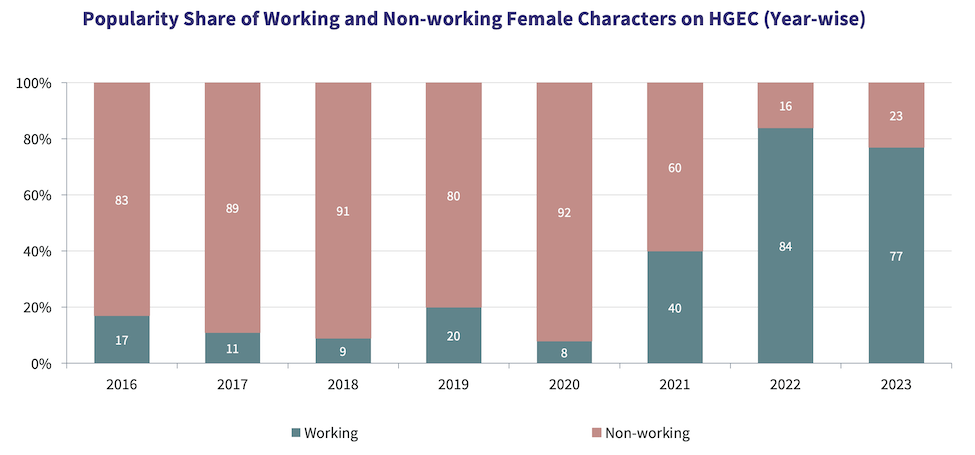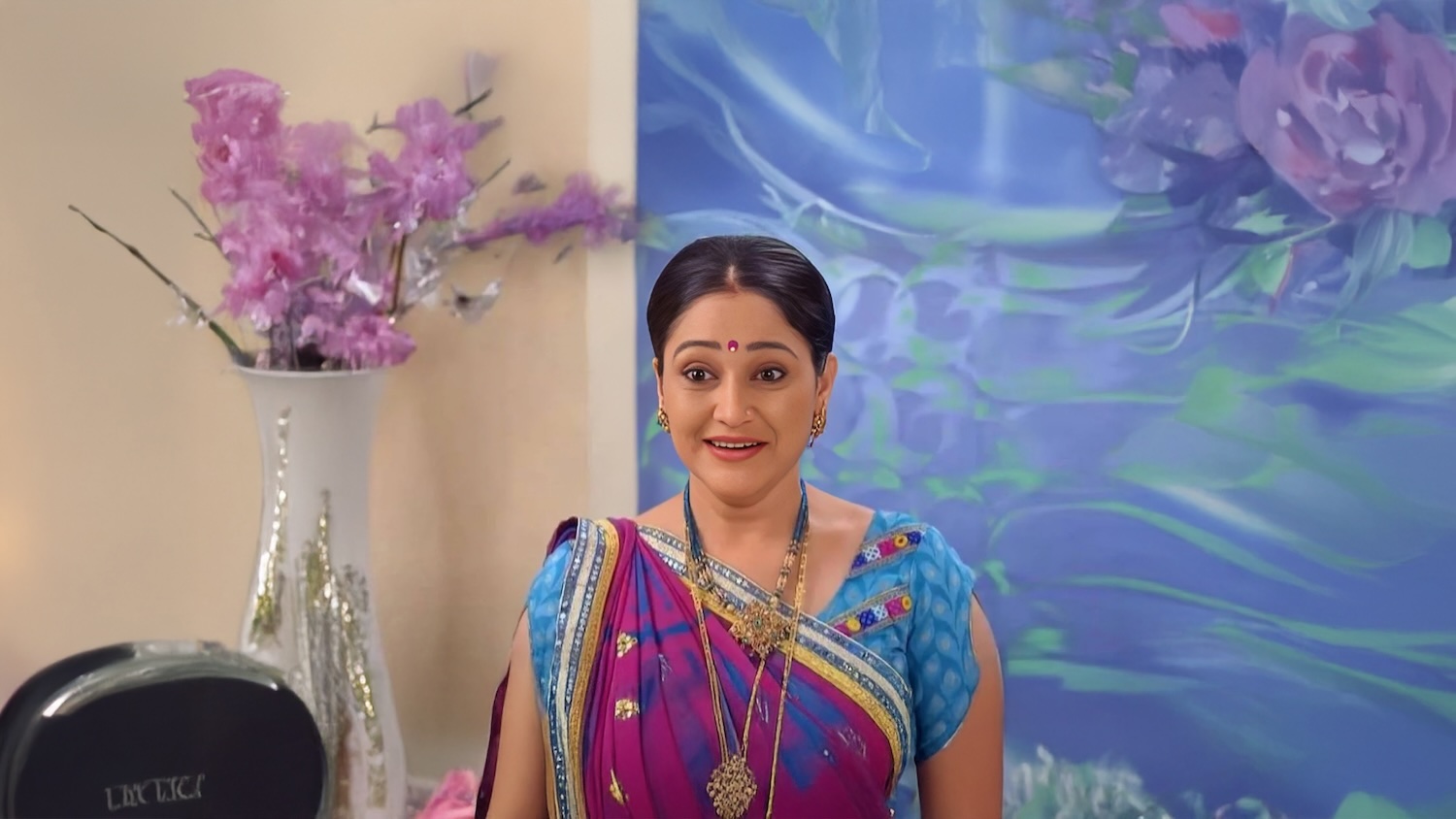


It may not seem so to an outsider, but the Hindi GEC category has witnessed a significant evolution in the portrayal of female protagonists over the years. From erstwhile depictions of them being traditional housewives or obedient daughters-in-law primarily entangled in kitchen politics with/without romantic subplots, recent narratives often revolve around themes of women education and career aspirations, marking a significant departure from stereotypical depictions of the past.
An 8-year trend analysis (2016-2023) of our popularity tracking tool for Hindi GEC characters Ormax Characters India Loves (OCIL) shows a remarkable transition in the occupational profile of the leading ladies across the category’s fiction shows.
In OCIL, Hindi GEC audiences are asked to name their favorite character across TV shows. The chart below depicts the share of working women among popular female characters, in each of these eight years. Male characters and non-fiction personalities have been excluded from this analysis. Numbers in the chart below reflect the popularity share breakup between working and non-working female characters.

The share of working female characters has increased from a negligible 13% (average of 2016 to 2020) to a staggering 80% in 2022-23. In 2021, our colleagues had conducted a similar analysis (read here) on female protagonists in Hindi theatrical films. While the progressive shift in cinema is more intuitive to understand, what makes the Hindi GEC progression on this parameter even more remarkable is how significant the shift has been in such a short time-period.
Let’s look at the various phases of evolution of lead female characters in Hindi GEC fiction shows to understand this shift.
Phase 1: The Traditional Indian Housewife
The 2000s (till the mid 2010s) witnessed iconic characters such as Tulsi (Kyunki Saas Bhi Kabhi Bahu Thi), Parvati (Kahaani Ghar Ghar Kii), Akshara (Yeh Rishta Kya Kehlata Hai), and Gopi (Saath Nibhaana Saathiya) ruling the ratings chart. These characters epitomized the role of the traditional Indian housewife, with her sole ambition being to become the perfect homemaker. Their stories revolved around the intricacies of domestic life, involving familial conflicts and motherhood challenges. Their husbands were invariably family scions, who had a business to run outside the home, and hence, were relegated to supporting roles in the post-marriage domestic phase of the female lead. These portrayals of female and male leads, while reflective of prevalent cultural norms, also contributed to reinforcing traditional gender roles and stereotypes.

Phase 2: Daring to Step Outside
In the decade 2010-2019, there was a notable shift in the types of characters who began to gain traction among audiences. Many of these popular leads in this period were from shows that challenged traditional gender roles, and depicted women with aspirations, beyond the confines of the home. Characters like Anandi (Balika Vadhu), Sandhya (Diya Aur Baati Hum), and Priya Ram Kapoor (Bade Achhe Lagte Hain) were some of the trailblazers from this phase.

Initially depicted as a child bride, Anandi’s journey in Balika Vadhu, took a transformative turn when she finally took up the role of a teacher, and then the village sarpanch. Through her character arc, the show highlighted the importance of education and empowerment for women, breaking the cycle of early marriage. The show Diya Aur Baati Hum introduced the character of Sandhya Rathi, a small-town girl whose journey, from being stifled in a forced marriage to fulfilling her dream of becoming an IPS officer post-marriage, became the story of hope, resilience, and empowerment. Sandhya’s will to achieve her dreams in the face of numerous obstacles resonated with audiences, particularly young women, who found in her a role model for breaking out of societal constraints and pursuing their aspirations fearlessly, while still fulfilling their familial obligations. In what was a fairly progressive take on women in 2011, Priya Ram Kapoor in Bade Achhe Lagte Hain was shown as an unmarried working woman in her 30s, providing financial support to her middle-class family.
These characters, while immensely popular, were still in minority in the last decade, with many other popular female characters still portraying traditional roles, typically housewives. But that has changed in the 2020s.
Phase 3: The Working Women
It is over the last 2-3 years that there has been a decisive shift in the occupational profile of almost all Hindi GEC female protagonists, as can be seen in the chart above. Most successful characters launched 2020 onwards have been shown as wanting to pursue higher education (classified as non-working), or are already working. The whole-hearted acceptance of these characters is heartening to say the least. Not only are these characters being depicted as working professionals, the narratives of their shows are putting an increased emphasis on education and career choices. Of course, there’s Anupama, the biggest of them all, who has headlined this significant shift, despite several challenges related to education and family circumstances.
The 23% share in 2023 for non-working characters is actually dominated by new age characters like law aspirant Abhira (Yeh Rishta Kya Kehlata Hai) or IAS aspirant Savi (Ghum Hai Kisikey Pyaar Meiin), in closing stages of their education in that year. They stand as testaments to this on-going progressive shift, embodying the aspirations and dreams of modern Indian women. It will be no surprise if we see the 90% mark being achieved in 2024.

The stories of these character reflect the challenges of navigating the professional world, along with juggling familial responsibilities, and this change is striking a chord with audiences. Audiences are no longer content with characters who do not reflect the reality today - they seek representation that resonates with their own aspirations and struggles.
While the family unit continues to remain at the core of Indian culture, the inclusion of working women in the Hindi GEC narratives signals a broader acceptance of women's roles beyond home. It celebrates the spirit of womanhood, in turn echoing the sentiment of the nation.
While much has been said about fiction content on linear television being regressive, and often rightly so, this fundamental shift in the category’s content is praiseworthy. Of course, there are many other shows that continue to be stuck in another era, but the audience popularity data from OCIL suggests that the audience would rather see working women than the stereotypical perfect homemakers. And that’s a refreshing development in a much-maligned category.

Venn It Happens: OTT & Linear TV audience intersection
The first edition of our new feature Venn It Happens illustrates the intersection between OTT and Linear TV audiences in India, using data from The Ormax OTT Audience Report: 2025

Not just nostalgia: Why legacy characters are dominating HGECs
Despite not featuring in the show since 2017, Daya (Taarak Mehta Ka Ooltah Chashmah) continues to enjoy immense popularity among Hindi GEC audiences. Her enduring success highlights a category trend

Ormax Mpact case study: Bandhan Mutual Fund on India Today TV
This case study, based on the integration executed by Bandhan Mutual Fund on English news channel India Today, showcases our Brand Lift measurement tool Ormax Mpact
Subscribe to stay updated with our latest insights
We use cookies to improve your experience on this site. To find out more, read our Privacy Policy